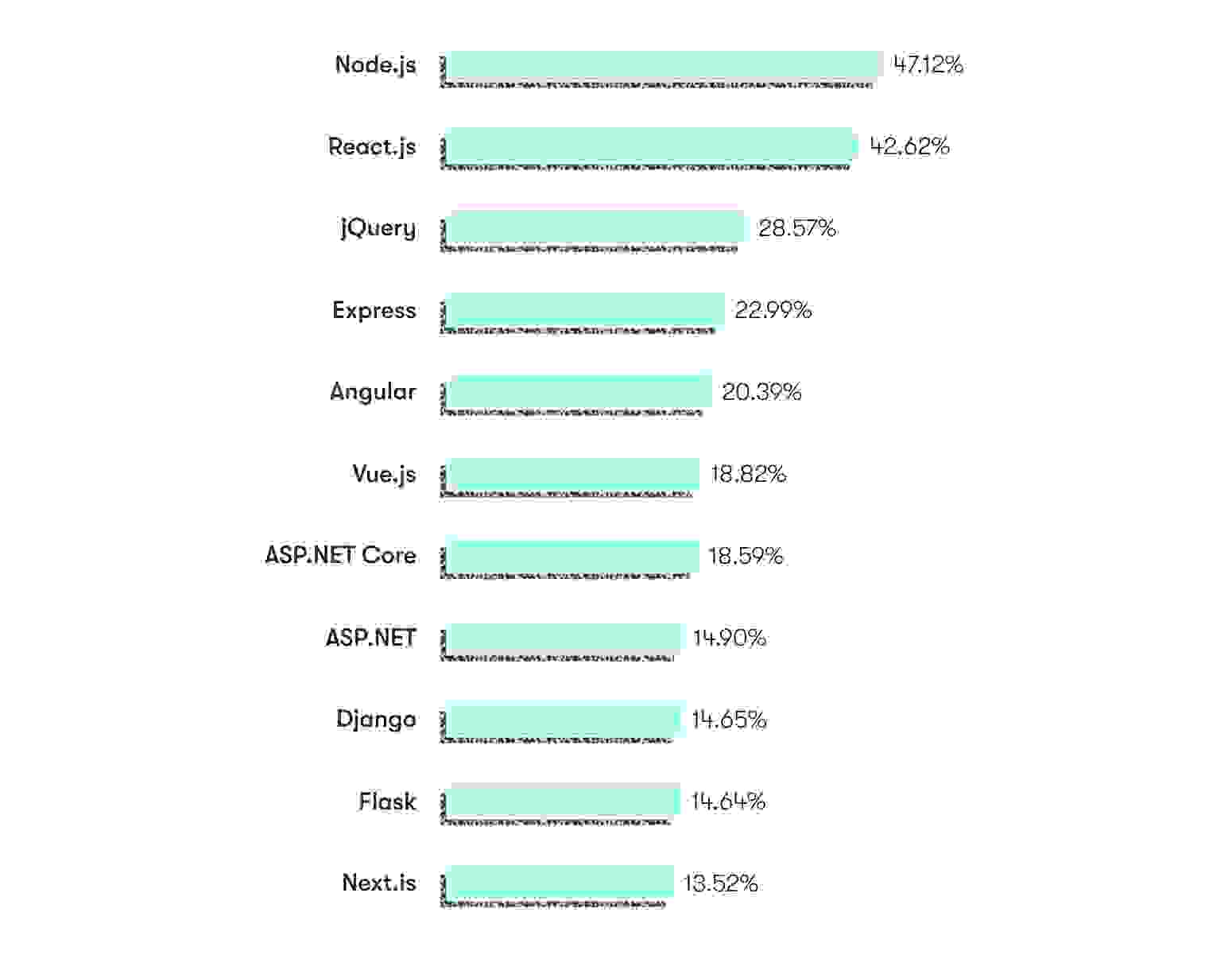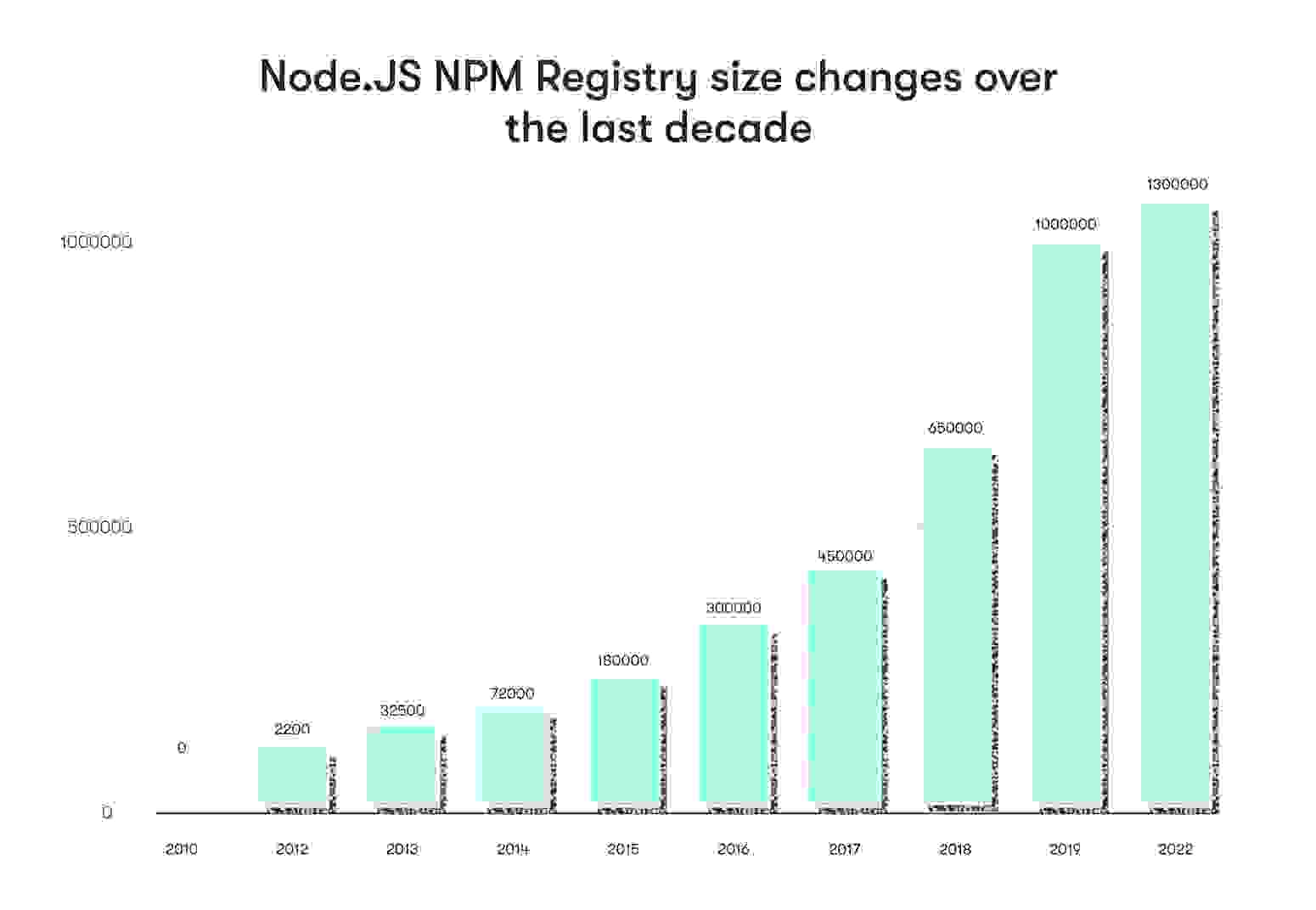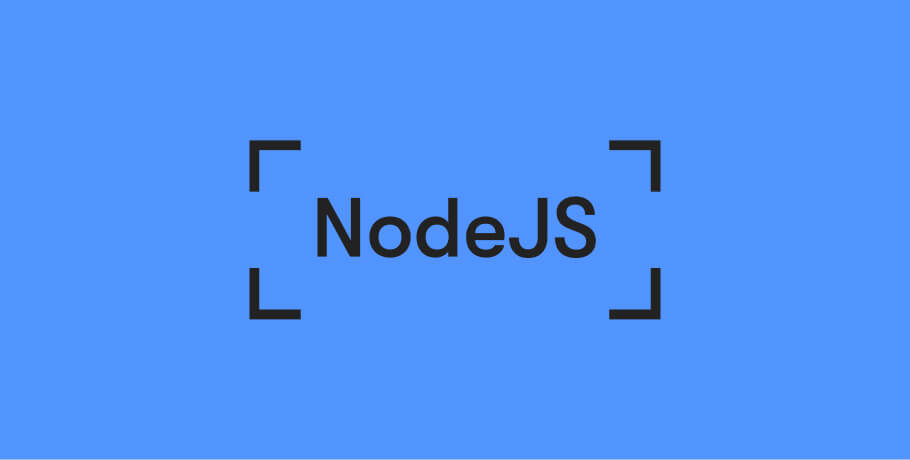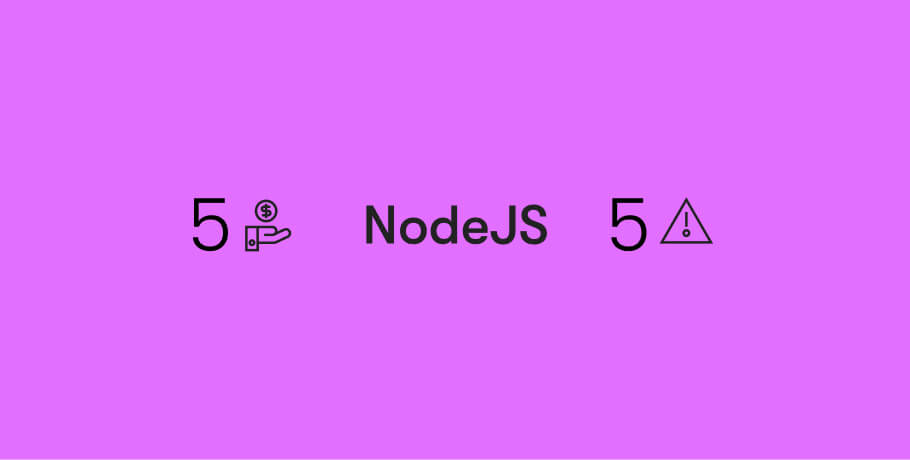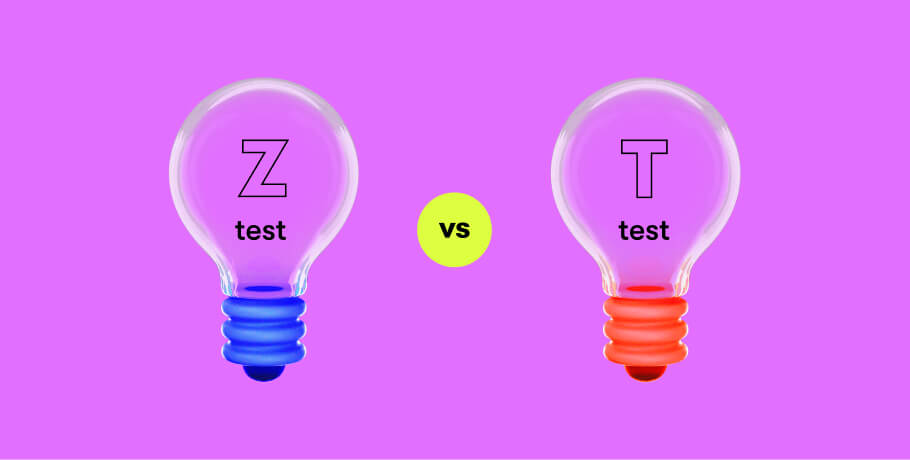Node.js is a runtime environment built on the V8 JavaScript engine, and is primarily used for creating both server-side and dynamic web applications. The technology isn’t just another backend development tool; it also allows performing frontend-related tasks. However, Node.js is used for backend most often among the frameworks. It has also been the fastest-growing framework for at least six recent years.
But does it mean you should rely on it as the ultimate backend technology? Answering that question depends on various factors which you must always consider carefully, and not choose this technology based on beliefs alone.

Let’s look closer at Node.js as a potential backend framework, analyze its pros and cons to best understand its strengths for backend. Doing so will help determine if Node.js is the right choice for your project development — and possibly prevent you from failing your project due to an improper tool selection.
Node.js key features and benefits that make it attractive
It’s obvious that the most popular web backend framework has plenty of advantages. Let’s quickly review them.
Has a huge professional community
One of the most evident advantages comes from the huge Node.js popularity among developers. There are at least several million people globally who can code in Node.js! This means you can always apply for Node.js developer jobs from anywhere you are.
Below you can find some links to the primary Node.js community resources.
- Official Node.js website
- Official twitter account
- Node.js-tagged questions at StackOverflow
- A Slack-based Node.js community
- A corresponding Dev.to thread
- Node.js thread at Quora
- A related subreddit at Reddit
- Website development services
Fullstack-ready
The Node.js framework is based on the JavaScript programming language. But the primary purpose of this language for many years was creating frontend elements and effects. Before Node.js was launched, there was no JS-powered backend at all.
Proficiency in Node.js means a solid knowledge of JS. This fact alone makes any hired Node.js developers already capable of full-stack development. The reverse is also true: all the frontend developers, with rare exceptions, are highly familiar with JavaScript and, in theory, can handle Node.js backend development activities.
Free from excessive rules and guidelines
Apart from most of the other web development frameworks, Node.js grants developers the freedom to create their apps from scratch with no pre-installed rules or obligatory guidelines.
This makes it possible to develop a single backend for different operating systems and platforms, including Windows, Linux, macOS, and the web. Such an uncluttered environment makes the development process smoother and free of legacy issues.
Highly scalable
This is one of the most notable Node.js perks. The starting package is quite streamlined out of the box, which makes it fast and lightweight. But you can add any required packages once they become needed, allowing you to increase the complexity of your app accordingly.
One standout ability of the event loop is to cover multiple requests in parallel. Your app can start as something simple and then become more and more sophisticated once the business grows. This translates to both the expansion of the feature set and adjusting to the continuously growing number of users.
Suitable for real-time and AI-powered applications
Node.js shows high efficiency with applications where high amounts of low-duty requests come most of the time. Among them are real-time applications (RTA) aimed, for example, at collaborative editing of documents or images. Another example of apps with an intense flow of lightweight requests are apps featured with AI.
A secret of success in such applications is the lowest possible latency. Node.js acts smart with the allocation of the available resources, sharing them among the different requests where it is possible, making some code pieces reusable, and providing lightning-fast client-server data synchronization.
Supports microservice architecture
Among other things, Node.js supports building microservices-based architecture. This makes it possible to wrap each app feature into a separate container, interacting with the others via an API.
This approach makes code pieces inside the containers fully independent of each other.
- You can add, disable, or even remove one or more containers at any moment with no risk of crashing for the remaining features.
- You can outsource the development of your microservices to different teams, and it won't deteriorate your app's overall quality.
- Even major updates usually have no effect on the whole app, instead limiting it to single microservices.
As a result, businesses receive a modular app with much lower scalability expenses.
Handles requests in parallel
Concurrent request processing is a capability Node.js developers can be proud of. This feature works more efficiently in Node.js than those in some other backend development technologies. Non-blocking I/O and Async support both make request processing streamlined and rapid. As a result, your application works fast and satisfies all the user experience expectations.
Both NPM and YARN package managers
NPM (Node Package Manager) and YARN (Yet Another Resource Negotiator) are package managers supported by Node.js. Both of these managers give businesses a way to develop projects less-expensively thanks to ready-made implementations usage.
The first one is a basic package management tool for this framework. Currently, the number of available packages released by third-party developers has exceeded 1,300,000. There is a special Enterprise version that works behind a firewall.

YARN is the child of Facebook, released as a measure against the risky usage of NPM. Since that time, the software became open-source, and is now supported by the community. The tool isn’t just a simple package manager; it also keeps the urgency of third-party packages under control.
When is it worth using Node.js for backend development?
Simple real-time apps without complex computations
Examples: instant messengers, collaboration tools, online conferencing apps, and community-oriented apps
As we said above, the superpower of Node.js is the fast processing of real-time requests in parallel. But there is a limitation on the overall size of the app: Node.js is only good for small applications with the same light requests.
Microservice-based apps for enterprise
Examples: Netflix, Uber
The microservice architecture allows virtually infinite scaling possibilities. There is no need to worry about possible app crashes once new features are released. All the engineer needs to do is just implement and test the required feature separately from the others, wrap it into a container, and then connect this new block of code to the API.
Streaming apps
Example: Netflix
Netflix is one of the brightest and most famous examples of Node.js usage for media streaming platform development. Thanks to the asynchronous requests, media file uploading is always running in the background, and safe from handicapping other parts of the application.
Serverless apps
Examples: any web app that can be serverless
The logic behind a “serverless” concept lies in the fact that within this architecture there’s no need to think about server infrastructure. All the server-side infrastructure is handled by a cloud provider fully under its control — and all required services are included.
As a result, developers don’t need to think about load levels, scalability during peaks, or any other questions related to the processing of their app in the data center. The serverless architecture is event-driven, which means the code is being executed as a reaction to a certain triggering event.
Single-page applications (SPAs)
Examples: any app within one URL
SPA means a rich web application implemented on a single web page. This makes it possible to load the page data from a server just once, and then change the state in answer to user interactions. Most changes are run right in the browser by executing JS code.
Node.js offers server-side page pre-rendering as a way to avoid some negative consequences of a client-side rendering, like the 56% search visibility drop Hulu faced in 2016.
It is also worth mentioning that Node.js could also be applicable to mobile app development services.
Backend for IoT
Examples: orchestration apps for IoT devices
Most IoT devices have a fairly simple internal structure, combining sensors, transceivers, batteries, as well as some additional elements. Instead of storing data in the internal memory, they just send it in real-time to a server. Node.js is a good option for developing such server-side IoT-controlling applications.
Apps where the response speed is crucial
Examples: video games, eBay, GoDaddy
This category intersects heavily with the others, as there are many web app types mentioned above that should also be the fastest possible.
- Messaging, collaborative, and other real-time apps where even barely noticeable delays negatively affect user experience.
- Ecommerce apps and websites — for example, eBay’s main requirement for their website is to be as close to real-time as possible.
- Successful gaming and gambling services are totally intolerant of any delays, due to it causing issues for players resulting in their high dissatisfaction.
For such demands, Node.js offers asynchronous non-blocking request handling, processing of data on a client-side without sending it to a server, as well as fast client-server interactions with instant data validation.
When shouldn't you use Node.js for backend development?
Alongside all the positives of Node.js usage within the backend development, there are a few negatives. Let’s review.
When development speed is crucial
A lack of excessive rules and guidelines encourages developers’ creativity, but may increase the average development time. Some things that can be used with a few clicks in other backend frameworks (like Ruby on Rails), Node.js developers must create from scratch. Even with all other things being equal, this single factor makes the implementation longer.
For heavy calculations
As we already mentioned, processing requests that require heavy calculations is, by far, not the best thing Node.js can do. Due to a single thread processing only, such complex computational tasks can block the event loop, decrease performance, or even lead to a crash of your application.
For simple apps with HTML/CRUD features only
Applications where the requests are limited by simple HTML protocol methods, or by CRUD operations, aren't the ones that should be built using Node.js. Such apps have no need for an API, receiving all the data from the server.
In this case, building your app on Node.js is like shooting a cannon at sparrows. HTML client-server request-response protocol contains nine methods only, while all four CRUD operations are among them, too:
CRUD operations | HTTP methods |
Create | POST |
Read | GET |
Update | PUT |
Delete | DELETE |
PATCH | |
TRACE | |
CONNECT | |
OPTIONS | |
HEAD |
When system crashes without recovery are unacceptable
Some apps must be built so that it is obligatory to recover all data in case of crashes. For example, a crash of a fintech solution without a data recovery feature can lead to severe financial losses. Due to a significant part of requests being processed right in the browser, Node.js makes recovering all data after crashes an unavailable option.
Within the projects where the open source elements cannot be applied
Sometimes security and reliability requirements are quite significant, numerous and prohibit using any third-party or open-source software within app development. For example, it’s obvious that every app for the military, police, or government must be free of such elements and the inherent risks they would bring. Due to the Node.js repositories being jam-packed with open-source items, it’s hard to develop your app fully ignoring third-party packages.
Use cases of backend development with Node.js
Yahoo and their SPAs
Yahoo started their relationships with Node.js in 2009 — less than a year after the framework’s initial release. Starting with the simplest tasks, Yahoo then expanded their Node.js usage. The framework championed by Yahoo developers is a highly scalable tool with great performance-increasing potential.
In 2018, Yahoo became a member of the Node.js foundation. Currently, the company has powered 75% of their web apps with Node.js.

GoDaddy goes Node.js
The famous and largest domain registrar in the world decided to choose Node.js as their new main backend technology. Within several years, the company had fully rebuilt its infrastructure. According to an interview with their senior developer Stephen Comisso, there were several goals for this drastic change:
- To have the capability of building web applications of higher quality
- For the immediate implementation of new features
- For easier integration and unit test writing
- For a more convenient REST API usage
- To access NPM (Node Package Manager)
The result is highly impressive: 10 times lower server load; from 60ms to 12ms drop in Time to First Byte; increased Google search rankings.
PayPal success
Despite the fact PayPal is a fintech business — where Node.js is hardly applicable — the company decided to use it to develop customer sides of their web applications.
As a result, they eliminated the existing gap between the server and client sides. The use of the same programming language helped PayPal to combine its development teams into one.
Other results by the numbers:
- Delivered 2 times faster with the help of a smaller team
- Code is reduced by 33%
- Repository now contains 40% fewer files compared with Java.
Conclusion
Node.js is a technology initially created for backend purposes. As a backend framework it isn’t universal, and is predominantly aimed at lightweight I/O-oriented web applications. Despite this fact, Node.js has become a global leader among web development frameworks. Yahoo, PayPal, LinkedIn, eBay, GoDaddy, Groupon, Mozilla, Uber, and Netflix are among the most famous Node.js business users.
Here are the main advantages of using Node.js for backend development we’ve found:
- Node.js works quite fast thanks to advanced client-server interaction processes, asynchronous requests processing, and no-blocking I/O, increasing both user satisfaction and SEO ranking.
- The framework is highly scalable and supports microservice architecture, making it possible to power web apps from the simplest to the most sophisticated.
- Node.js repositories contain about 1.3 million third-party packages for making the development process cheaper and faster.
- Node.js is best when aimed at lightweight real-time applications, single-page applications, apps based on a microservice architecture, apps for media streaming, serverless, IoT backend, as well as apps designed for the fastest response times.
FAQ

The EPAM Anywhere Editorial Team is an international collective of senior software engineers, managers and communications professionals who create, review and share their insights on technology, career, remote work, and the daily life here at Anywhere.
The EPAM Anywhere Editorial Team is an international collective of senior software engineers, managers and communications professionals who create, review and share their insights on technology, career, remote work, and the daily life here at Anywhere.
Explore our Editorial Policy to learn more about our standards for content creation.
read more

